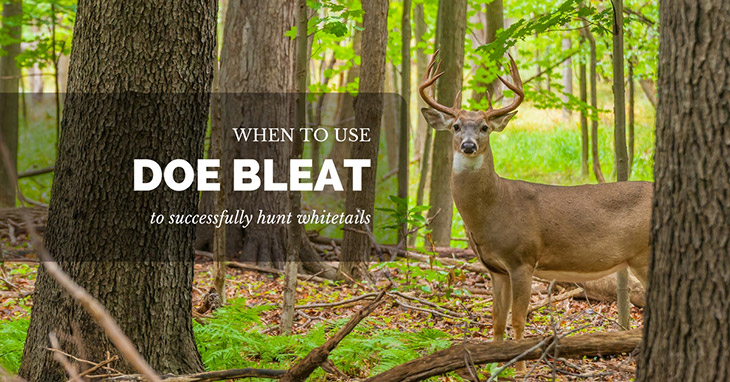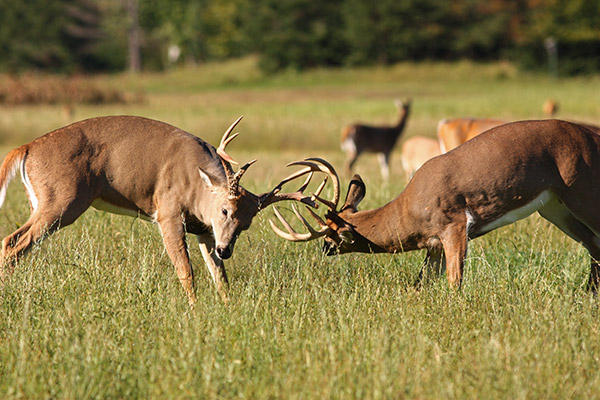Bleating has many uses and advantages, but do you really know when to use doe bleat? Many hunters have tried, but only some succeeded because most of us didn’t understand how whitetails communicate all season long. I used to ask myself why I wasn’t able to attract a doe before I learned when to use a doe bleat, and I was amazed when I finally realized what I have been doing wrong all this time. Without further ado, here are some of the things that I would like to share for all you aspiring hunters out there about whitetails and the right time to use doe bleats:
Seasons Are Very Important
Do not use doe bleats in the early season because you will just end up wasting your time. Yes, you can hunt all season long, but not with a doe bleat. Let me make this clear for all of you – What you always need to know is that the most important seasons, when to use a doe bleat, would be the pre-rut and rut season.
The pre-rut season begins at the beginning of autumn. This means that bucks will start to get aggressive with each other, and they will end up breaking out of their group to find their own territory. When this happens, does it mean that you have to finally use a signal? No. Not yet. You still have to wait because it just means that a buck is already keeping tabs on a doe.
When the rut season finally takes place starting at the end of October or the beginning of November, and when a buck successfully mates with a doe, a buck will always travel and bed where the doe goes. When this happens, you can use the doe bleats to attract and hunt them both.
So, what is the importance of pre-rut and rut season? You may be asking yourselves why you need to wait for so long to hunt bucks, does, or even fawns, but here is the deal: You just have to know the right time, because if you do, you will surely hit two birds with one stone. Yes, you read that right! When you use doe bleats during mating season, you will probably end up calling both a doe and a buck, or even the whole family.
Understand The Communication
Seasons are not the only thing important. You also have to study and understand how whitetails communicate with each other may it be through vocal, chemical, or visual. They have other ways to communicate, but I believe that these are their most common ways of communication. You don’t need to know about their chemical and visual communication because usage of doe bleat does not fall into these categories, but let me tell you about vocal communications.
Whitetails use vocal communications for alarm and distress, territory dispute, nursing, and mating, but the usage of doe bleats do not apply to all of these. A doe will surely answer a doe bleat to nurse a fawn, but she will not heed your call during mating season. To make things easier, let me break down the importance of knowing when to use doe bleat on certain circumstances and communications.
Alarm and distress
Does are just like our mothers — they have maternal instincts. Fawns bleat when they are in danger or if they are being attacked by predators, and their mothers will always come to the rescue when they hear this sound. Use a doe bleat properly to sound an alarm, and you will be able to successfully hunt a doe.
Nursing a fawn
Fawns also bleat when they are very hungry or if they need their mother’s attention, and does will always go where the sound came from. Some hunters have tried using a doe bleat that sounded like a fawn, and they went home happy.
Conclusion
In totality, you must use doe bleats during the right season, and at the right time. I personally recommend Primos Hunting Calls because the family pack has three different kinds of bleats which you can actually use for hunting: the original can for mating signal, the little can that makes a high pitch sound for alarm and distress, and nursing, and the great big can that makes longer and louder beats. You can find this family pack by clicking HERE. Don’t call out a doe if they haven’t mated yet or if they don’t even have a fawn in the first place. Do you understand that? If not, here is just a simple reminder: You need to know what signal you must use, because only then can you succeed in calling and hunting whitetails.
I hope this article helped you to know when to use a doe bleat. If you have questions, please feel free to leave a comment below.
References:
http://isowhitetails.com/when-and-how-to-call-deer/
https://www.whitetailsunlimited.com/i/p/bk_deertalk.pdf
http://www.deeranddeerhunting.com/article-index/bleatperformance



2 Comments. Leave new
[…] may also snort if they are concerned, alarmed, or feel like they are in danger. Deer use their sense of sight, smell and hearing so that they can […]
[…] can be attributed to the nutritional status as not all the older bucks feed well during the breeding season. They skip many meals during this […]